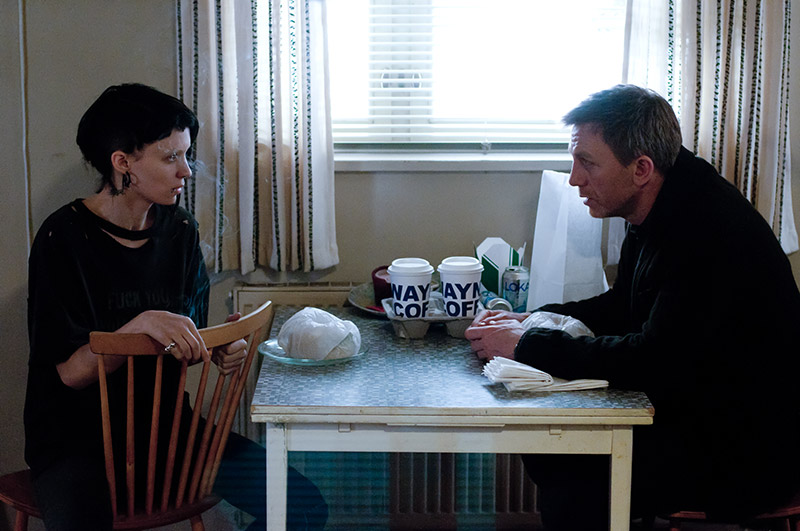
I found it nearly impossible to watch David Fincher’s The Girl with the Dragon Tattoo without the spectre of Niels Adren Oplev’s adaptation prodding my expectations. Objectivity became even more strained as events inched ever closer to that scene. The traumatizing effect of its Swedish predecessor clouded the entire first act of the film (a cloud condensed by the Chatty Kathys to my left and the individual below to whom I had to ask — twice — to put his damn phone away). Consequently, I believe I did a disservice to Fincher’s vision as most of that first act passed by in a haze. When that scene finally arrived it turned out to be several scenes. Fincher mercifully intercuts the sexual brutality inflicted on central heroine Lisbeth Salander (Rooney Mara) with the concurrent mystery that is the true narrative kernel of Stieg Larsson’s novel. While I cannot say that the editing blunts the violence, it nevertheless gives the audience a chance to breathe.
With the unpleasantries disburdened, Dragon Tattoo unfolded more organically. The film itself is a living entity, its pulse quickening and abating in its own biorhythm: Salander’s motorcycle merging in perfect synchronicity with a train on a parallel course; her and news writer Mikael Blomkvist (Daniel Craig) working feverishly at separate strands of the same intriguing tapestry until their paths collide. Sadly, Fincher missteps by placing a minor opening subplot front and center for a near twenty-minute epilogue that enfeebles the preceding drama.
Said drama is photographed in refreshing clarity. Fincher painstakingly paints every frame of his films and Dragon Tattoo is icily stunning. The cold panes of a glass house seem to look directly at Blomkvist as he searches its austere rooms. Cinematographer Jeff Cronenweth’s camera alternately soars and stills, proving finally that digital photography can break the video blur barrier. Kirk Baxter & Angus Wall’s editing and Trent Reznor & Atticus Ross’ scoring waltz in step and give the film life.
For her part, Mara positively owns the character of Lisbeth Salander, her cut-you-as-soon-as-look-at-you attitude belying a vulnerability and an ever-watchful terror that haunts her wherever she goes. Like Thelma & Louise before her, Salander refuses to let sexual violation rob her of her sexual confidence, and she places her trust in her instincts.
Craig, unfortunately, has difficulty stripping the patina of James Bond from his far too capable skin. He’s also the only one who neglects to adopt a regional accent, joining fellow 007 Sean Connery in his belief that his provincialism is sufficiently international for every language and dialect.
Speaking of, the title sequence is highly evocative of the recent Bond movies with a heavy dose of Nine Inch Nails edginess as it plays out to their cover of The Immigrant Song. This could be Fincher’s audition for a future Bond film, as he’s already been attached to (and released from) the Mission: Impossible series (could his connection with Craig lead to another collaboration?). Of course, interesting title sequences are nothing new to Fincher and they are a clever barometer for measuring the atmosphere of his films, and Trent Reznor’s growling vocals superbly evoke the disturbance and derangement that lie at the heart of The Girl with the Dragon Tattoo.
Goes great with: The Girl with the Dragon Tattoo (2009). Because it’s a fun and interesting film school exercise to compare the vision of two directors to the same material.
Disagree? That’s fine by me. Share your thoughts below.

4 responses to “Second wind”
I can’t decide if I should read the book first or see the movie first.
Always a struggle. For me, I’ve found that I’ve enjoyed movies more if I haven’t yet read the book. My enjoyment of a book is rarely blunted by my viewing of the movie.
The real question is which film version you should see first. I would suggest seeing the Swedish version first as I found Fincher’s to be the overall superior.
* * * SPOILER ALERT * * *
I’ve only seen the 2009 Swedish film and I didn’t read the novel, but I’m wondering if the Fincher’s remake made Lisbeth’s entrapment of her rapist any more plausible. Lisbeth turns up at the rapist’s home claiming she needs him to release more of her money. He knows she’s smart enough to expect he’ll commit more unspeakable acts upon her. Once he had her tied up on the bed, wouldn’t his most likely first act be to humiliate her a little by going through her luggage and discovering her camera?
Don’t confuse sadism with intelligence.